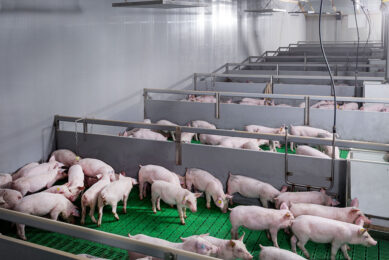The key features of antibiotic alternatives

The use of non-antibiotic growth promoters (NAGPs) has been increasing globally as a result of pressure to maintain a sustainable, whilst cost effective, animal production. Understanding the main aims and challenges of NAGP is key to securing healthy livestock.
Ideally, alternatives to AGPs should exert the same beneficial effects as AGPs. Recent findings demonstrate that control of pathogens at subclinical level is only a minor mechanism of AGPs and that reduction of inflammation is indeed the main mode of action behind the growth promoting activity of AGPs. This perhaps explains the consistent effect of drug-based AGPs compared to several NAGPs. Therefore, it is reasonable to say that effective NAGPs should be inhibitors or at least moderators of inflammatory response.
AGPs v’s Non-AGPs
The primary aim of AGPs is the gut, a fundamental organ system, which performs several equally important functions; digestive, absorptive, metabolic, as well as immunological (host defence) and endocrinological functions.
Although extensive in vitro research has been carried out on single ingredients that exert a direct antibacterial effect against specific pathogens little is known about their anti-inflammatory effects. Even less work has been done to understand how multiple ingredients may work in combination. It is believed that a combination of different compounds that provide multiple modes of action may hold the biggest promise as antibiotic alternatives in animal feed for four major reasons:
- Single antibiotic alternatives fail to meet the sum of the beneficial effects of antibiotics.
- A possible synergistic effect from different alternatives. This may lead to reduction of the required effective dosage.
- Gut integrity can be strengthened in the presence of specifically selected alternative compounds reducing leaky gut syndrome and cases of diarrhoea and wet litter.
- The host immune response may be enhanced with an integrated approach.
Figure 1 – Anti-inflammatory effects of Lumance (250 ppm) and its ingredients.

Despite the growing body of evidence on improvement of overall animal performance with the combined use of more than one NAGP ingredient, the existing literature on the ability of these combinations to suppress the inflammatory response is relatively scarce. Here, the synergistic anti-inflammatory activity of Lumance is reported, as evaluated in a well-established gut epithelial cell model (Figure 1). A similar beneficial activity has been demonstrated in vivo (both under experimental and field conditions) with a number of anti-inflammatory biomarkers such as C-reactive protein and host defence peptides.
Figure 2 – Effects of Lumance and LPS on intestinal barrier integrity measured by TEER in IPEC-J2 cells.

Supplementing with Lumance enhanced significantly the tight junctions even under bacterial enterotoxin (LPS) challenge in a well-established model used for the study of intestinal barrier functions (Figure 2). This is of particular importance, taking into account that several stressors can increase the gut permeability leading often to chronic inflammation and disease. In fact, it is believed that animals raised in intensive production systems experience gut dysbiosis or defective host defence towards invasive bacteria, triggering the immune response of the gut, which most probably is in a constant inflammatory response. For example, it has been proven that Deoxynivalenol (DON) as well as fumonisins can increase the gut permeability and predispose for Clostridium perfringens induced necrotic enteritis in broiler chickens. In other words, DON can replace coccidiosis (i.e. infection by several Eimeria spp.) as a predisposing factor for necrotic enteritis.
The need for rigorous field data
Of course, it is fundamental that the performance of NAGPs are evaluated where they are meant to act, i.e., in the field. Lumance has been used successfully in different geographies, farming conditions, animal species (including aqua), genetics, climates and legislation frameworks in terms of use of AGPs. The product has proved until now the only effective programme for simultaneous replacement of both ZnO and antibiotics (neomycin), used traditionally to prevent post-weaning diarrhoea in pigs. It is estimated that more than 10 million animals have been treated in Spain for simultaneous replacement of neomycin and ZnO and have been reared successfully in real large-scale farming conditions, whilst improving their performance.
In recent years, the feed additives market has been flooded by myriads of NAGP blends comprising (wholly or partially) of plant-based materials; both plant extracts or essential oils. However, the origin, quality and consistency of such materials, most of the times, remain a big question mark. Moreover, several terms are coined in the market when referring to such ingredients like: ‘natural’, ‘natural-identical’, ‘natural-like’, ‘extra natural’ or ‘premium extra natural’ rendering the landscape rather hazy. The oregano within the Lumance Technology comes from 100% natural Greek oregano (Origanum vulgare hirtum) which results in superior anti-inflammatory activity versus synthetic carvacrol.
‘Formulation’ properties of non-AGPS
It is true that someone may develop and prove the ‘ideal’ NAGP (under experimental conditions either in vitro or in vivo) by combining several ingredients however, two big questions remain; Is the new solution affordable? Can the ‘novel’ NAGP withstand pelleting and extrusion processes, as the additive will be eventually mixed with the rest of the feed and will be exposed to high temperatures for several minutes? Lumance has, in fact, undergone such rigorous testing with practically no losses for its essential oils and fatty acids. Liquid intervention of novel NAGPs is another important feature, whereby exerting similar mode of actions and able to be combined in the drinking water for short periods of time without any restrictions, unlike AGPs.
In conclusion, feed additives or better said, in-feed technologies, can be a good alternative to antibiotic replacement only when supported by rigorous data (in vitro and in vivo) on each animal species and condition tested. This data should elucidate their exact mode of action and prove their thermal as well as shelf-life stability.
Author: Dr Christos Gougoulias, Head of Innovation, Innovad
 Beheer
Beheer





 WP Admin
WP Admin  Bewerk bericht
Bewerk bericht